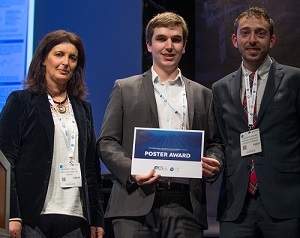

The winners of this year’s edition are:
First prize (€1,500): Anthony Gray (IDCORE)
For the study: Identifying Key O&M Strategy Considerations for a Wave Energy Array: A Case Study on Pelamis
Anthony Gray, Lars Johanning

ABSTRACT
Wave energy is a young, growing industry with huge potential. Operations and maintenance (O&M) is a vital area of research in the push to make wave farms a commercial reality. An EngD research project sponsored by Wave Energy Scotland (WES) seeks to address the issue of uncertainty surrounding lifetime costs of wave energy arrays using an O&M simulation tool. The tool has been built around the Pelamis P2 device (figure1). Between 2008 and 2014, the two Pelamis P2 machines gained over 11,000 grid connected hours at the European Marine Energy Centre (EMEC) in Orkney. This vast knowledge and experience can be used to analyse different O&M strategy considerations and reduce the levelized cost of energy of future wave energy arrays.
Second prize (€1,000): Rachael Moore (Queen’s University Belfast)
For the study: Investigating Tools Used to Analyse the Impact of a Wave Farm on the Surrounding Wave Field
Rachael Moore, Louise O’Boyle and Bjoern Elsaesser

ABSTRACT
For wave energy to become commercially viable, it is predicted that wave energy converters (WECs) will need to be installed in large wave farms. This will required an extensive environmental impact study. Assessments of impacts of these sites requires prior numerical modelling however the available tools have not been fully validated.
This project investigates the area surrounding an array of five scaled WEC models using experimental techniques. It then assesses the suitability of numerical tools to be validated with this experimental data. Validated numerical tools could then be used to predict parameters relating to the models such as reflection and transmission coefficients.
The physical aspect of this project was conducted in the Portaferry wave basin owned by Queen’s University Belfast. The device studied was a bottom hinged oscillating wave surge converter (OWSC) which penetrates the surface (similar to the Oyster device). The models were tested at 40thscale.
Third prize (€ 500): H. C. Jeong (Mokpo National Maritime University)
For the study: A Numerical Study on the Performance of a Water Wheel Type Tidal Turbine
M. H. Nguyen, H. C. Jeong, B. G. Kim, J. H. Kim, C. J. Yang

ABSTRACT
Hydrokinetic conversion systems, albeit mostly at its early stage of development, may appear suitable in harnessing energy from such renewable resources (tides, wind, etc.). A concept of tidal energy converter (TEC) which is based on shape of the conventional water wheels, is introduced in this study. Basically, this turbine has several special features that are potentially more advantageous than the conventional tidal turbines, such as propeller type tidal turbines. The research aims to study the potential possibility of eleven-blade turbine using Computational Fluid Dynamics (CFD) in extracting the hydrokinetic energy of tidal current and converting it into electricity, and evaluate the performance of the turbine at different given arrangements of blades which are inclined to the wheel centerline with angles of 0, 10, 20 and 30 degrees. In all cases of tip-speed ratio (TSR), the straight blades type (or inclined to the wheel’s centreline with an angle of 0 degree) showed the most effective performance than the others. In the other words, this type extracts tidal stream energy better than all cases in the study. In addition, the torque extraction at the rotor shaft of the 0 degree inclined blade type is the most uniform comparing to the others due to the less interrupted and fluctuated generation of force for a period of time.